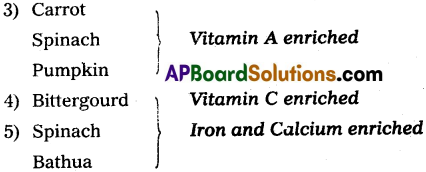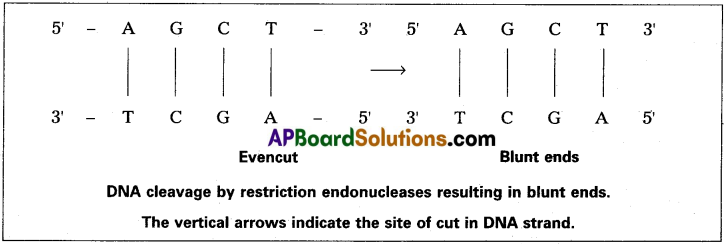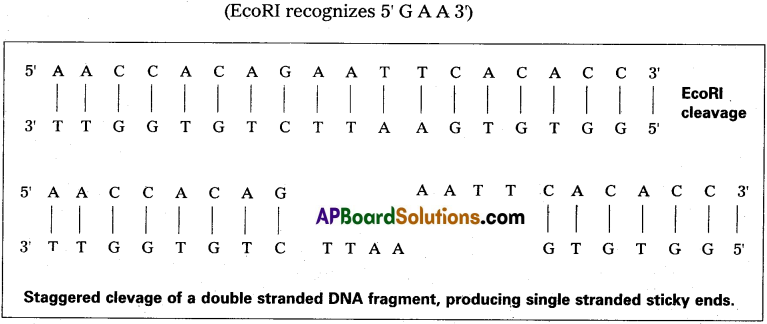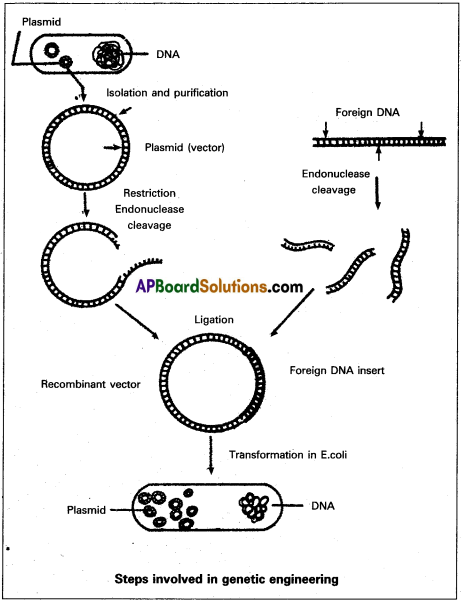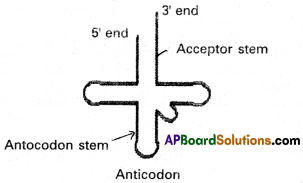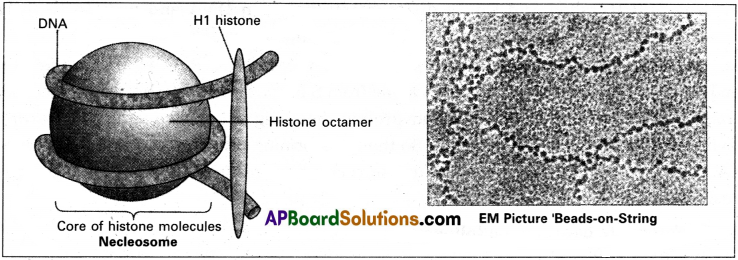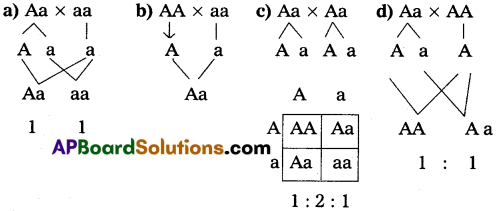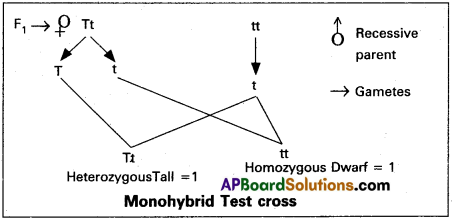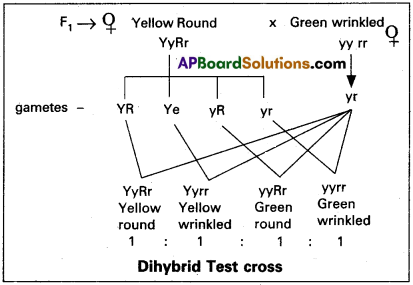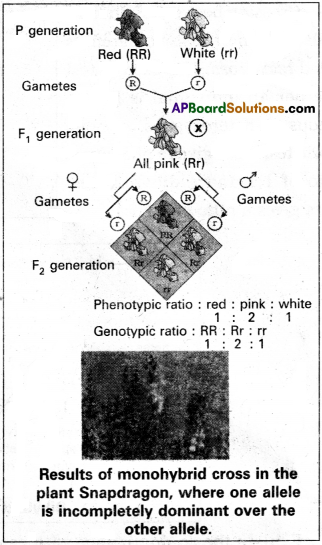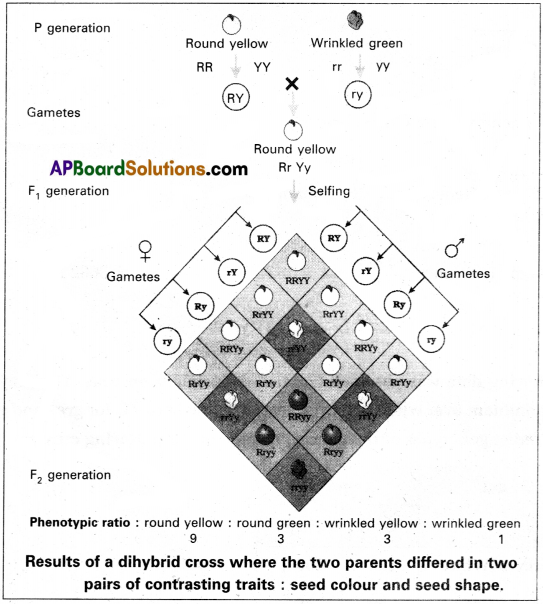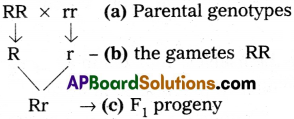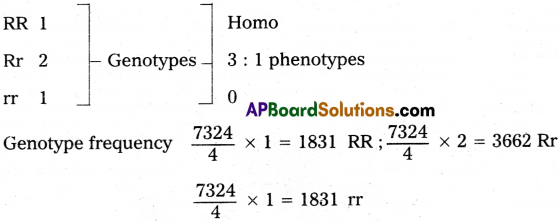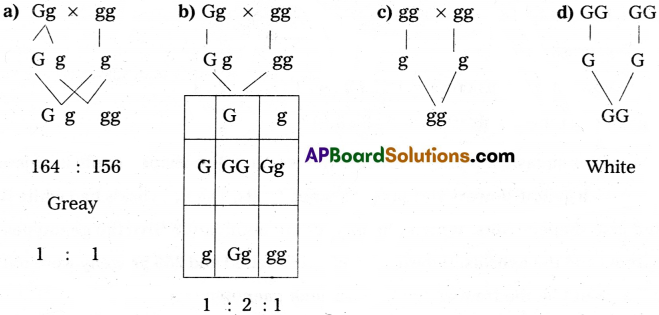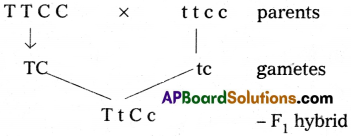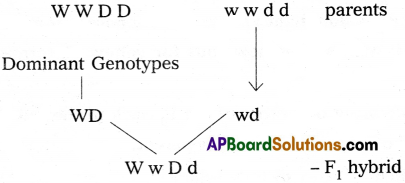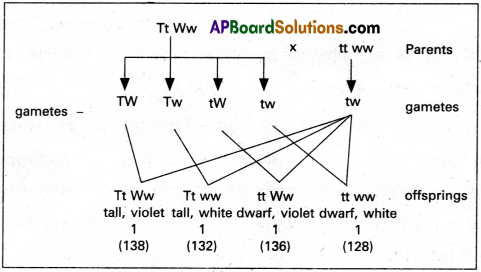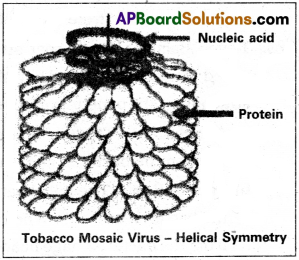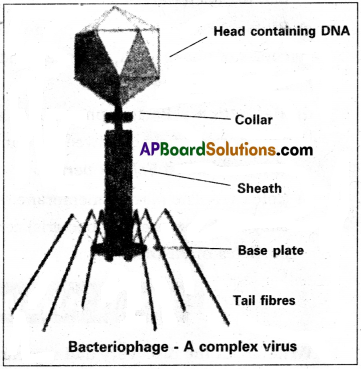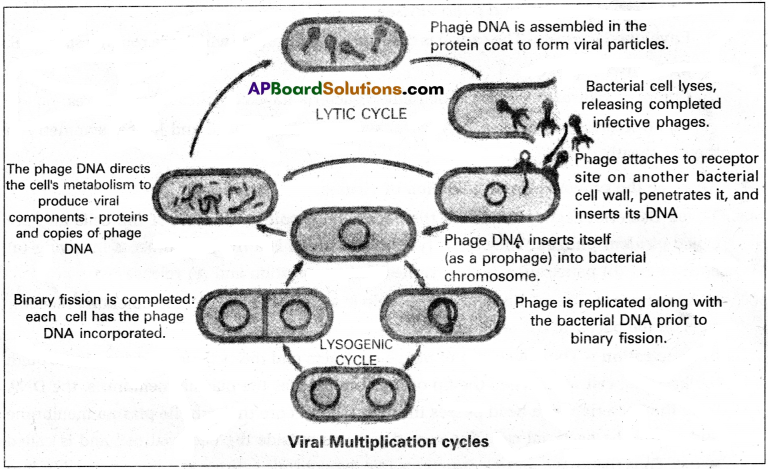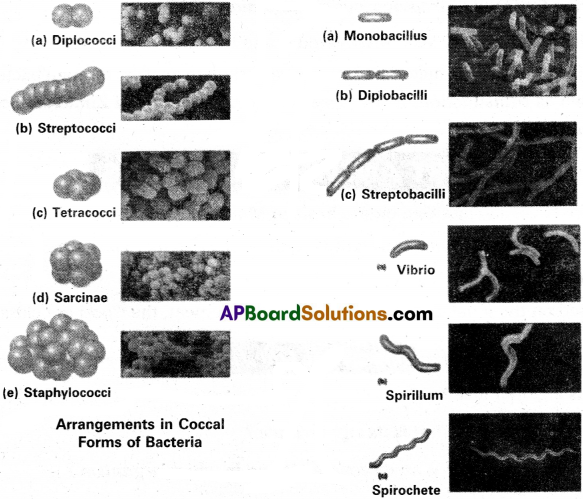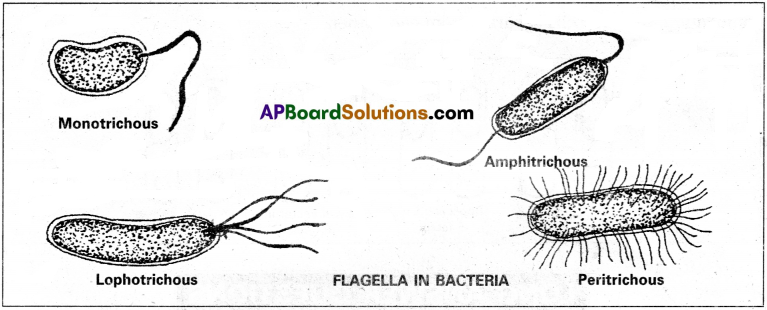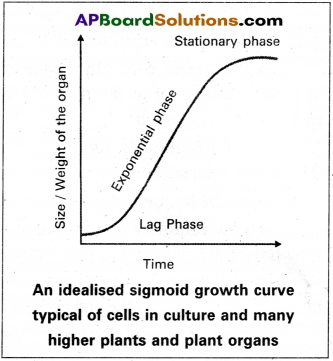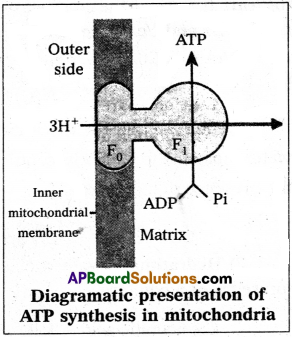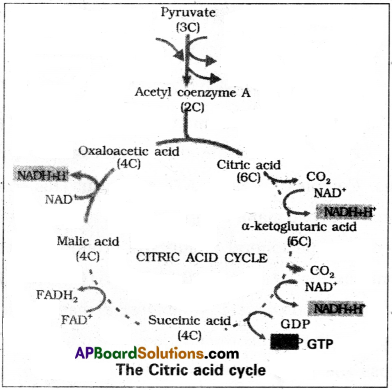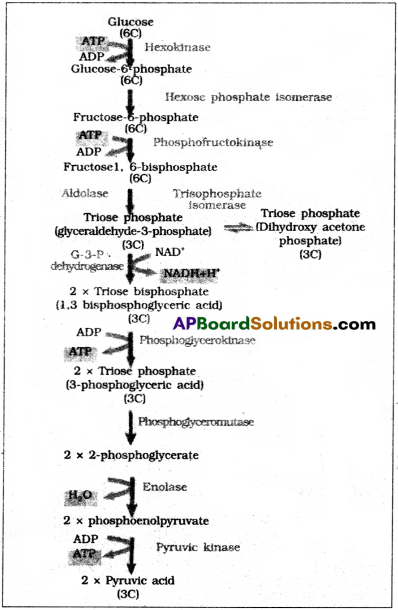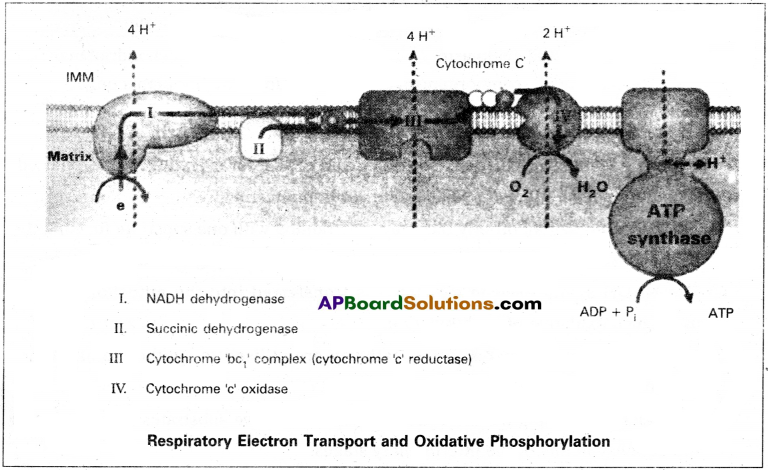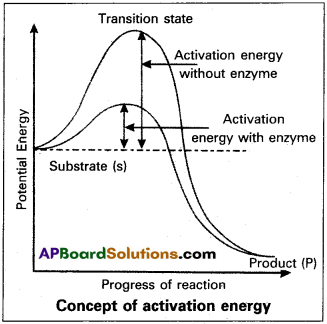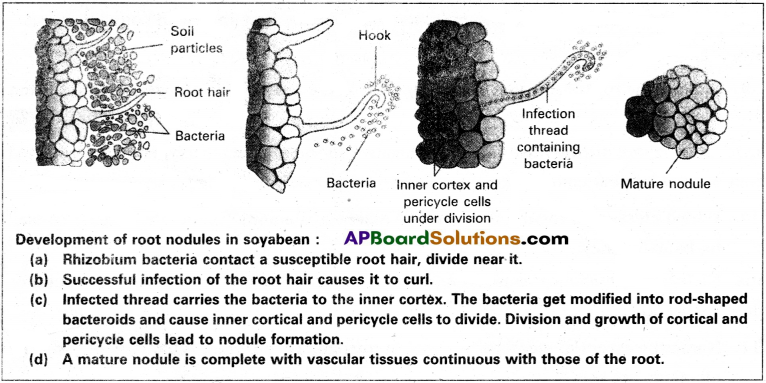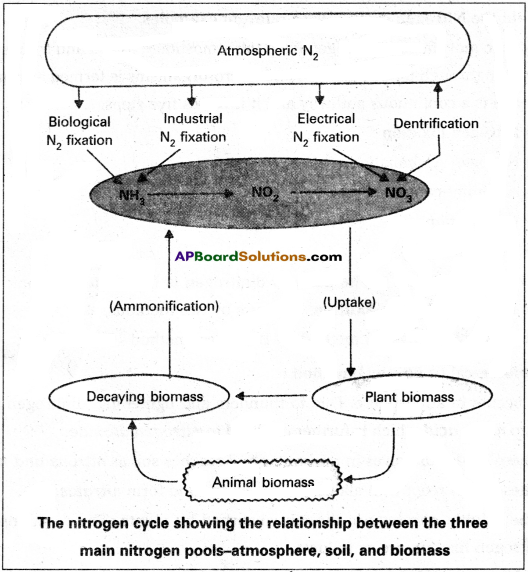Andhra Pradesh BIEAP AP Inter 2nd Year Botany Study Material 14th Lesson Microbes in Human Welfare Textbook Questions and Answers.
AP Inter 2nd Year Botany Study Material 14th Lesson Microbes in Human Welfare
Very Short Answer Questions
Question 1.
Why does ‘Swiss cheese’ have big holes? Name the Bacteria responsible for it.
Answer:
The large holes in ‘Swiss cheese’ are due to the production of large amounts of CO2 by Propionibacterium shamanic.
Question 2.
What are fermenters?
Answer:
These are large vessels in which microbes are grown in large numbers on an industrial scale.
Question 3.
Name a microbe used for statin production. How do statins lower blood cholesterol levels?
Answer:
Monascus purpureus statins act by competitively inhibiting the enzyme responsible for the synthesis of cholesterol.
Question 4.
Why do we prefer to call secondary waste water treatment as Biological treatment?
Answer:
The primary effluent is passed into large aeration tanks where it is constantly agitated mechanically and air is pumped into it. This allows vigorous growth of useful microbes into floes while growing these microbes consume the major part of the organic matter in the effluent, which reduces the BOD (Biochemical oxygen demand).
Question 5.
What is Nucleo polyhedro virus is being used for now-a-days?
Answer:
These viruses are excellent candidates for species-specific, narrow spectrum insecticidal applications. They have been shown to have no negative impacts on plants, mammals, birds, fish or even on non-target insects.
![]()
Question 6.
Write the most important characteristic that Aspergillus niger, Clostridium butylicum and Lactobacillus share.
Answer:
The microbes are acid producers. E.g. : Aspergillus niger (a fungus) produce citric acid, Clostridium butylicum (a bacterium) produce butyric acid and Lactobacillus (a bacterium) produce lactic acid.
Question 7.
Name any two genetically modified crops.
Answer:
Bt-cotton, Bt-brinjal.
Question 8.
Name any two industrially important Enzymes.
Answer:
Lipases, Streptokinase.
Question 9.
Name an Immuno suppressive Agent. From where it is obtained?
Answer:
Cyclosporin-A, Trichoderma polysporum.
Question 10.
What is the group of Bacteria found in both the rumen of cattle and sludge of sewage treatment?
Answer:
Methanogens – Methanobacterium.
Question 11.
Name the scientists who were credited for showing the role of Pencillin as an antibiotic. Ernst chain and Howard florey after Alexander Fleming.
Short Answer Questions
Question 1.
How do mycorrhizal fungi help the plants harbouring them?
Answer:
The symbiotic association between fungal members and roots of vascular plants is called mycorrihiza. Many members of the genus Glomus forms Mycorrhiza. The fungal symbiont in these associations facilitates absorption of phosphorous by the plant from the soil. Plants having such associations show resistance to root-borne pathogens, tolerance to salinity and drought and an overall increase in plant growth and development.
![]()
Question 2.
What is the chemical Nature of Biogas? Explain the process of Biogas production.
Answer:
Biogas is a mixture of methane (CH4), Co2, traces of H2S and moisture. It is generated by the decomposition of excreta or dung of cattle, domestic waste material and industrial and agricultural sewage due to the activity of anaerobic bacteria (Methanococcus and Methanobacillus) present in them. It is used as fuel. The Bacteria which grow anaerobically on cellulosic material product large amount of Biogas, and the Bacteria are called Methariogens.
E.g : Methano bacterium commonly found in the anaerobic sludge during sewage treatment and also present in the food of cattle and in the rumen of cattle. In rumen, this bacteria help in the breakdown of cellulose and play an important role in the nutrition of cattle. The excreta or dung can be used for generation of Biogas (Gobar gas).
Question 3.
What ire Biofertilisers? Write a brief note on them.
Answer:
Organisms that enrich the nutrient quality of the soil are called Bio fertilisers.
E.g.: Bacteria, Fungi and Cyanobacteria.
1) Bacteria :
In symbiotic Bacteria, Rhizobium is present in the root nodules and legumes. These Bacteria fix atmospheric Nitrogen into organic forms which is used by the plant as a nutrient. Other Bacteria can fix atmospheric Nitrogen, while free living in the soil are Azospirillum and Azotobacter thus enriching the Nitrogen content of’the soil.
2) Fungi :
The symbiotic association between fungal members and roots of vascular plants is called mycorrhiza. Many members of the genus Glomus forms Mycorrhiza. The fungal symbiont in these associations facilitates absorption of phosphorous by the plant from the soil. Plants having such associations show resistance to root-borne pathogens, tolerance to salinity and drought and an overall increase in plant growth and development.
Long Answer Questions
Question 1.
Write brief essay on microbes in sewage treatments?
Answer:
Municipal waste-water is also called sewage. It contains large amount of organic matter and microbes, many of which are pathogenic. This sewage cannot be discharged into natural water bodies before disposal, sewage is treated in sewage treatment plants to make it less polluting treatment of waste water is done by heterotrophic microbes naturally present in the sewage. This treatment is carried out in two stages.
1) Primary treatment:
It involves physical removal of particles from the sewage through filteration and sedimentation. Floating debris is removed by seanential Alteration. Then the grit (soil & small pebbles) is removed by sedimentation.
All solids that settle form the primary sludge and the supernatant forms the effluent. The effluent is taken for the secondary treatment.
2) Sedbndary treatment or Biological treatment:
The primary effluent is taken into large tanks where it is constantly agitated mechanically and air is pumped into it. This allows vigorous growth of aerobic microbes into floes. While growing, these microbes consume the major of the organic matter in the effluent. This significantly reduces the BOD of the effluent. The sewage water is treated till the BOD is reduced. Now the effluent is passed into a settling tank where the bacterial floes are allowed to sediment. This sediment is called activated sludge.
This activated sludge is pumped into aeration tanks (small amount) and anaerobic sludge digesters (large amount). Here other kind of bacteria which grow anaerobically, digest the bacteria & fungi in the sludge. During this digestion bacteria produces a mixture of gases such as methane, H2S & CO2. The effluent from the secondary treatment plant is released into natural water bodies like rivers and streams.
Intext Questions
Question 1.
Bacteria cannot be seen with the naked eye, but these can be seen with the help of a microscope. If you have to carry a sample from your home to your biology laboratory to demonstrate the presence of microbes under a microscope, which sample would you carry and why?
Answer:
Curd can be used as a sample for the study of microbes. Curd contains numerous lactic acid bacteria (LAB) or lactobacillus. These bacteria produce acids that coagulate and digest milk proteins. A small cup of curd and contains millions of bacteria which can be easily observed under a microscope.
![]()
Question 2.
Give examples to prove that microbes release gases during metabolism.
Answer:
Bacteria and fungi carry out the process of Fermentation and during this process, they release CO2. Fermentation is the process of converting a complex organic substances into a simples substance with the action of bacteria or yeast. Fermentation of sugar produces alcohol with the release of CO2 and little energy. The dough used for making idli and dosa gives a pubbed appearance due to the release of CO2.
Question 3.
Name the states involved in Ganga action plan.
Answer:
Uttarakhand, Uttar Pradesh.
Question 4.
Name some Indian traditional Indian foods made of wheat, rice and bengals gram (or their products). Which of these food involve the use of microbes?
Answer:
a) Wheat products – Bread, Cake
b) Rice products – Idli, Dosa
c) Bengal gram products – Dhokla, Khandvi
Question 5.
In which way have microbes played a major role in controlling diseases caused by harmful bacteria?
Answer:
Several microorganisms are used for preparing medicines. Antibiotics are medicines produced by certain microorganisms to kill other disease causing microorganisms. These medicines are commonly obtained from bacteria and fungi. They kill or stop the growth of microorganisms.
E.g.: Pencillium notatum produces, pencillin which checks the growth of staphylococci bacteria.
Question 6.
Do you think microbes can also be used as a source of energy? If yes, how?
Answer:
Yes, microbes can be used as a source of energy. Bacteria such as methane bacterium used for the generation of gobar gas. The dung is mixed with water to form the slurry and thrown into the tank. The tank is filled with numerous anaerobic methane bacteriun which produce bio gas from slurry. Bio gas can be removed through the pipe and is then used as a source of energy, while the spent slurry is removed from the outlet and js used as a fertilizer.
Question 7.
Microbes can be used to decrease the use of chemical fertilisers and pesticides. Explain how this can be accomplished?
Answer:
Microbes play an improtant role in organic farming, which is done without the use of chemical fertilizers and pesticides. Biofertilisers are living organisms which help increasing the fertility of soil. Biofertilisers are introduced in seeds, roots or soil to mobilize the availability of nutrients. Thus they are extremely beneficial in enriching the soil with organic nutrients. Thus cyanobacteria have the ability to fix free atmospheric nitrogen. Rhizobium is a symbiotic bacteria found in the root nodules of legumes.
Biofertilizers are ecofriendly microbes can also act as biopesticides to control insect pests in plants. E.g.: Bacillus thuringiensis which produce a toxin that kills the insect pests. Dried bacterial spores are mixed in water and sprayed in agricultural field, which larvae of insects feed on crops, these bacterial spore enter the gut of the larvae and release toxins, thereby it dies. Trichoderma are free living fungi. They live in the roots of higher plants and protect them from various pathogens. Baculoviruses is another biopesticide that is used as a biological control agent against insets and arthropods.
Question 8.
Three water samples namely river water, untreated sewage water and secondary effluent discharged from a sewage treatment plant were subjected to BOD test. The samples were labelled A, B and C; but the laboratory attendant did not note which was which’. The BOD values of the three samples A, B and C were recorded as 20 mg/L, 8 mg/L and 400 mg/L respectively. Which sample of the water is most polluted ? Can you assign the correct label to each assuming the river water is relatively clean?
Answer:
BOD (Biological Oxygen Demand) is the method of determining the amount of oxygen required by microorganisms to decompose the waste present in water supply. If the quantity of organic waste in the water supply is high, then the number of decomposing bacteria present in the water will also be high. As a result, the BOD value also will increase.
Therefore it can be concluded that if the water supply is more polluted, then it will have a higher BOD value out of the above three samples, sample C is most polluted since it has the maximum BOD value of 400 mg/L. After this, secondary effluent discharge from a sewage treatment plant is most polluted. Thus sample A has the BOD value of 20 mg/L while sample B is river water and has the BOD value of 8 mg/L. Hence correct label for each sample is.
A – 20 mg/L – Secondary effluent discharge from a sewage treatment plant
B – 8 mg/L – River water
C – 400 mg/L – Untreated sewage water.
Question 9.
Name of the microbes from which Cyclosporin A (an immunosuppressive drug) and Statins (blood cholesterol lowering agent) are obtained.
Answer:
Cyclosporin A – Trichoderma polysporum
Statin – Monascus purpureus
![]()
Question 10.
Find out the role of microbes in the following and discuss it with your teacher.
a) single cell protein (SCP) b) Soil.
Answer:
a) Single cell protein :
It is a protein obtained from contain microbes which forms an altenate source of proteins in animal feeds. The microbes involved are algae, fungi, yeast or bacteria. These microbes are grown On an industrial scale to obtain the desired protein. E.g.: Spirulina can be grown oh waste materials obtained from molasses, sewage and animal manures. It seves a rich supplement of dietary nutrients such as proteins, carbohydrates, fats, minerarls and vitamins. Methylophilous methylotrophus have a large rate of Biomass production, produce large amounts of proteins.
b) Soil:
Soil microbes play an important role in maintaining soil fertility. They help in the formation of nutrient rich humus by the process of decomposition. Many species of bacteria and cyanobacteria have the ability to fix atmospheric nitrogen into usable form. Rlizobium is a symbiotic bacteria found in the root nodules of legumes. Azospirillum and Azetobacter are free living nitrogen fixing bacteria.
Question 11.
Arrange the following in the decreasing order (most important first) of their importance, for the welfare of human society. Give reasons for your answer. Bio gas, Citric acid, Penicillin and Curd.
Answer:
Penicillin → Biogas → Citric acid → Curd
Pencillin:
It is the most important product (Antibiotic) for the welfare of Human society. It is used for controlling various bacterial diseases.
Biogas :
It is an eco-friendly source of energy.
Citric acid :
It is used as a food preservative.
Curd:
A food item obtained by the action of lactobacillus bacteria of milk.
Question 12.
What is sewage? In which way can sewage be harmful to us?
Answer:
Sewage is the municipal waste matter that is carried away in sewars and drains. It includes both liquid and solid wastes, rich in organic matter and microbes. Many of these microbes are pathogenic and can cause several water borne diseases. Sewage water is a major cause of polluting drinking water. Hence it is essential that sewage water is properly collected, treated and disposed.
![]()
Question 13.
What is the key difference between primary and secondary sewage treatment?
Answer:
| Primary sewage tratement | Second sewage tratement |
| 1) It is a mechanical process involving the removal of coarse solid particles. | 1) It is a biological process involving the action of microbes. |
| 2) It is inexpensive and relatively less complicated. | 2) It is a very expensive and compli- catedprocess. |
